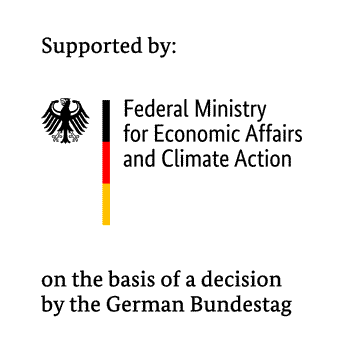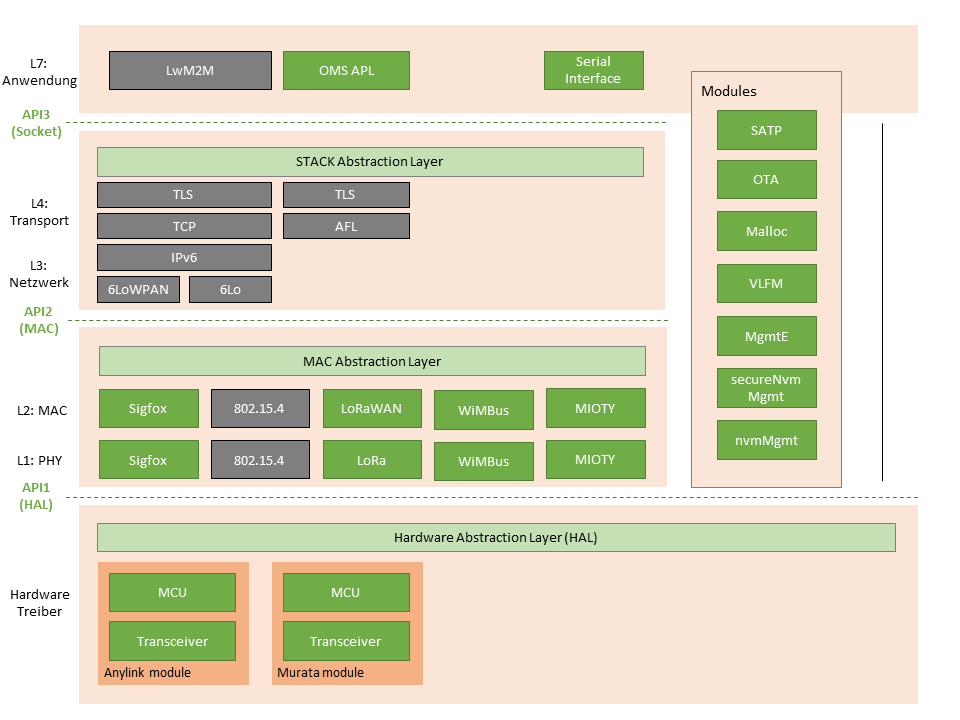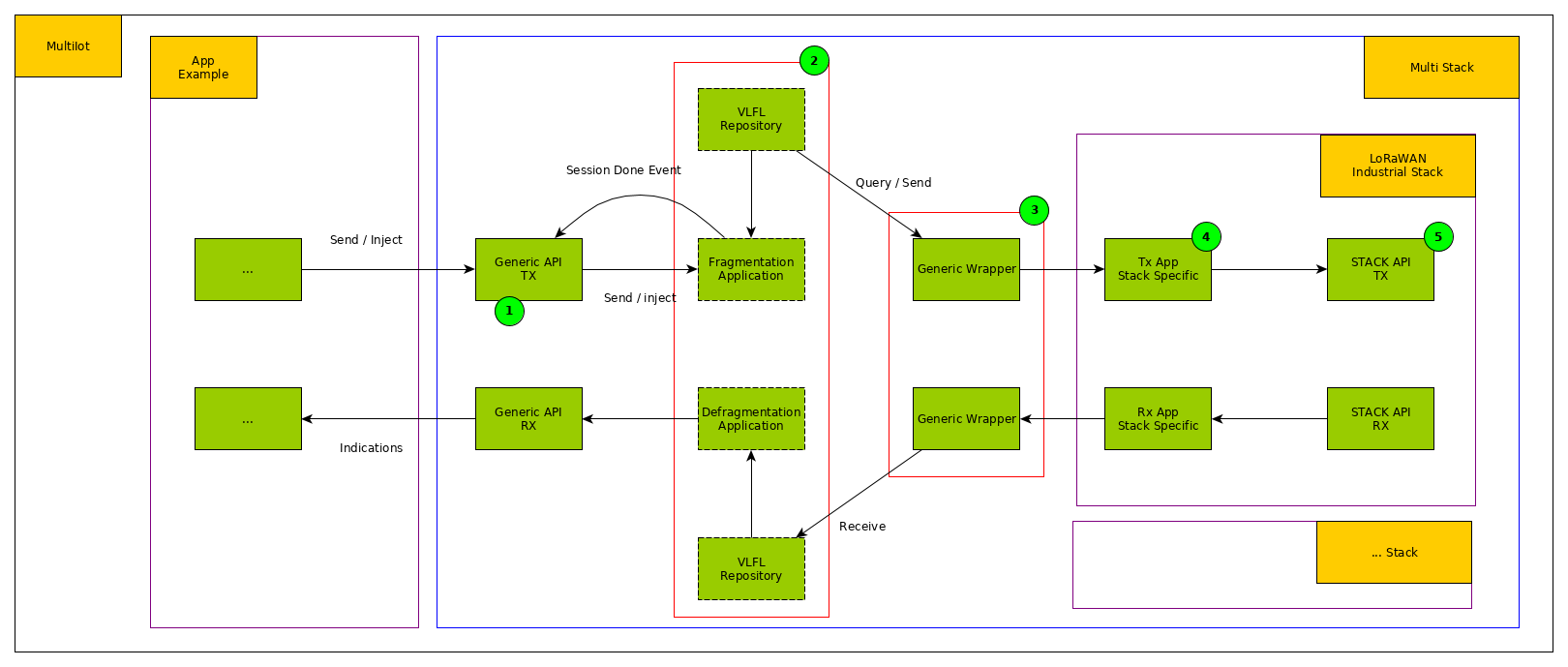Multi-IoT
The development focus of the funding project for the Central Innovation Programme Mittelstand (ZIM) of the German Federal Ministry for Economic Affairs and Energy (BMWi) was on multi-protocol-capable radio nodes for Low Power Wide Area Networks (LPWAN) in the Internet of Things. Wireless network technologies play a central role in the Internet of Things and are developing rapidly. The transceiver ICs of the latest generation offer the possibility to realize different modulation and coding procedures, protocols and even a fairly large frequency range with one hardware solution. The multi-protocol-capable radio nodes should support several protocols at the same time and can switch between them during runtime. In addition, the radio nodes are to have uniform hardware and software interfaces in order to achieve cost advantages in development and production for applications with small and medium quantities.
STACKFORCE GmbH was able to realise several projects and also a product during the implementation phase from 09/01/2018 to 06/30/2020. We are proud to have been able to contribute our many years of expertise to several work packages of the project.

intention
Task: Implementation of a generic HAL
To implement multi-IoT software, it is necessary to define and implement several APIs (application programming interfaces). In order to fully specify and implement the necessary interfaces (API1, API2, API3), several adaptations and architectural changes were made to the existing protocols. For this purpose, the LoRaWAN, wM-Bus and Sigfox communication stacks were adapted to the requirements or adapted software was implemented.
For abstraction of the unified API1, the drivers of the radio modules of the company Anylink Systems AG (type: DPM1276 DROPIN) and the company Murata (type: CMWX1ZZABZ) regarding the control of the transceivers were combined and completely mapped via a HAL (API1). Similarly, the methods for controlling the respective microcontroller were standardized and abstracted via an HAL (API1).

Task: Implementation of the MIB (L1/L2)
As a Management Information Base (MIB), the Management Entity developed in the ParsiFAl 4.0 funding project will be used as a basis and expanded and modified for the current project. STACKFORCE also took care of the development of a generic management module for the non-volatile storage of configuration data in a fixed memory „non-volatile memory“ (NVM). This module allows different memory ranges of an NVM to be assigned to multiple applications or protocol implementations.
In addition, a module has been developed to implement a generic solution for a firmware update via the air interface. The module consists of two software components:
- Part 1 deals with the selection and verification of a firmware and the organization of the flash memory.
- Part 2 contains the algorithms of error detection and error correction of a firmware transmitted via the air interface.
To support a firmware update via the air interface, variable data fragmentation (firmware) is unavoidable, as the different protocols specify different sizes of maximum usable data to be transmitted. Similarly, the maximum useful data length of a transfer can be automatically adapted to the LoRaWAN protocol depending on the data rate. Therefore, generic and variable fragmentation and defragmentation were specified and implemented.

task: Integration of existing L1/L2 protocols
By integrating the existing protocols on L1 and L2, the protocols LoRaWAN in version 1. 2, Sigfox in version 1 and wM-Bus in accordance with EN13 757-4 have been integrated. These three protocols can be used separately or in combination (wM-Bus protocol with one of the LWPAN protocols LoRaWAN or Sigfox). It was also possible to integrate a pre-compiled library for the innovative mioty protocol.
The protocol implementation LoRaWAN supports the operating classes Class A, B and C. In addition, both the protocol implementation and the driver of the wireless module control support the regions ETSI and FCC. The protocol implementation Wireless M-Bus supports the modes C1, C2, S1, S1-m, S2, T1 and T2. In each mode, the role of a meter as well as the role of a data concentrator can be realized.
testing phase
Within the test validation phase unit test were created for various required modules. The test phase was partly brought forward and worked in parallel with the other work packages, so the modules “SATP”, “VLFM” or “nvmMgmt” could be developed with a high level of testing already during the implementation. Component tests were continuously updated and expanded by the necessary adjustments to the individual protocol implementations.
Summary and results
The defined work packages were implemented as planned. During the project period, a first generic hardware abstraction (HAL) for radio modules of different manufacturers was developed and implemented. Now, regardless of the protocol implementation used, the same hardware drivers can be used. The management module developed for the non-volatile storage of configuration data in a fixed memory provides overall greater efficiency. Through this development, the management configurations of the different communication stacks can be organized via a shared module and the memory access can be optimized. In addition, this approach allows easier porting to new hardware. Implementing a generic fragmentation module for a firmware update via the air interface has the advantage of splitting large utility data into several packets, thus minimizing data loss.
During its work on the Multi-IoT funding project, STACKFORCE was able to gain important insights for the existing products in its own portfolio and to adapt and expand them for multi-IoT requirements. This is how the Multi-Stack was created.
multi stacks - our flexible solutions
Our Multi-Stacks offer the possibility to choose between several stacks and radio standards, such as mioty®, LoRaWAN®, wireless M-Bus, OMS, Sigfox and others. This flexible solution allows you to achieve maximum usability when you connect your product to the Internet of Things (IoT).
Any Questions?
If there are any questions regarding our contribution to the Multi-IoT project, don't hesitate to

